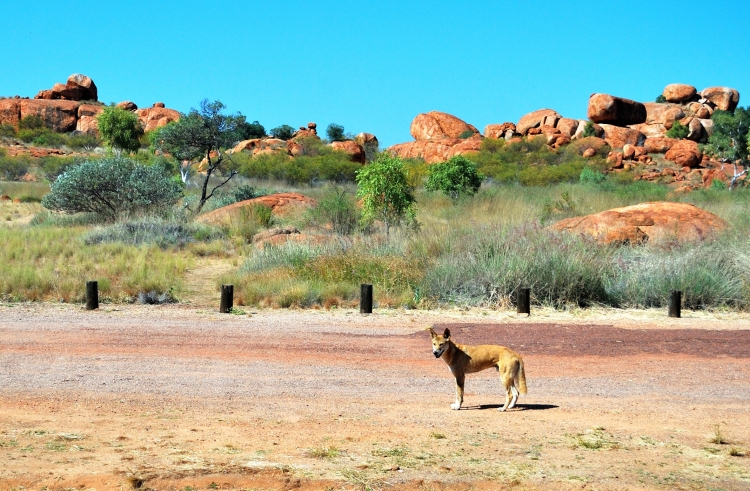
Karlu Karlu
by Marilyn Humbert
The cold, razor wind of July
scarves and scars the round red rocks,
eucalypt leaves sigh in a modulated minor key.
Burnt upright sticks cast slender shadows
and untouched silk white boles flash
in the ghost light of star fall.
He pads soundless, wild and unkempt,
dew dipped hair gleams beneath the full moon’s glare,
snarling lips expose needle-point teeth
as his voice rolls in the rush of river-song.
This night of dingo howls
star sparkles and moonbeams,
he sings of keening kites,
mouse burrows lined with winter-grass
and jigsaw tales of wattle flowers.
He croons the bush curlew’s dirge
through the filaments of dusk and dawn
‘til embers glow blood red
and he fades in the shadows
of Karlu Karlu.
PHOTO: Wild dingo at Karlu Karlu (Devils Marbles), Northern Territory, Australia. Photo by Marco Saracco, used by permission.
NOTE: Karlu Karlu / Devils Marbles Conservation Reserve is a protected area in the Northern Territory of Australia, about 244 miles north of Alice Springs. The area is of great cultural and spiritual significance to the traditional Aboriginal owners of the land, and the reserve protects one of the oldest religious sites in the world as well as the natural rock formations found there. Karlu Karlu is the local Aboriginal term for both the rock features and the surrounding area. The Aboriginal term translates as “round boulders” and refers to the large boulders found mainly on the western side of the reserve. In 2008, ownership of Karlu Karlu/Devils Marbles was officially passed from the Parks and Wildlife Service of the Northern Territory back to the Traditional Owners. The reserve is now leased back to the Parks Service under a 99-year lease, and the site is jointly managed by rangers and Traditional Owners.

NOTE: The dingo is a wild dog found in Australia, with a habitat that covers most of the continent. As Australia’s most predominant terrestrial predator, dingoes prey on mammals up to the size of the large red kangaroo, in addition to birds, reptiles, and fish. A dingo pack usually consists of a mated pair, their offspring from the current year, and sometimes offspring from the previous year. The dingo plays a prominent role in the Dreamtime stories of indigenous Australians.
PHOTO: Dingo, Karlu Karlu (Devils Marbles), 2011 by Adam Gormley, © All Rights Reserved.

NOTE FROM THE AUTHOR: We were camped beneath the rocks. This night, just on dusk, a dingo trotted through the campground—bold, nonchalant, without a care—and disappeared into the darkness.
PHOTO: Sunset at Karlu Karlu, Australia. Photo by Benny Marty, used by permission.

ABOUT THE AUTHOR: Marilyn Humbert lives in the Northern suburbs of Sydney, New South Wales, Australia. Her free-verse poems have been awarded prizes in competitions, published most recently in Ethelzine Vol. 6 and Black Bough Poetry Deep Time Vol 2. Her tanka and haiku appear in international and Australian journals, anthologies, and online.
Nothing intelligent to say, I just LOVE this poem and you get me there, to that space, at the time of night. Thank you
LikeLike
thank you Rose.
LikeLike